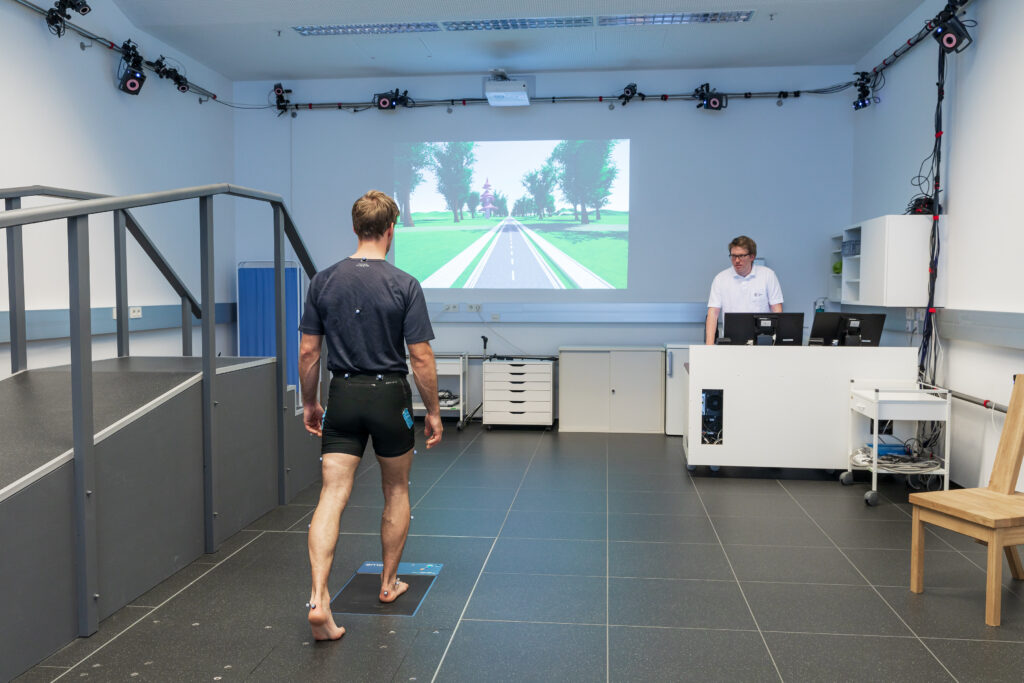Background
Degenerative musculoskeletal disease patterns (e.g., osteoarthritis) are an increasing challenge for those affected and also for government health care systems. In the therapy and prevention of functional deficits in the lower extremities (e.g. after joint replacement), relearning physiologically correct movement patterns is a key success factor. The learning effect is only achieved through frequent and correct repetition of a movement sequence. Furthermore, the motivation to perform the training sustainably and on one’s own responsibility is essential for success. The motivation can be positively influenced by instrumentally supported real-time feedback with serious gaming elements.
Instrumented feedback is currently available mainly for gait training and balance training in the form of cost-intensive and complex technologies. Initial approaches to smart supported training are being found in the fitness industry. In general, however,there are hardly any products available for feedback-supported individual self-training that are based on evidence-based norm data. Approaches to the development of such systems can be found in the literature.
User-acceptable feedback systems with low-threshold access and intuitive usability have the potential to contribute to the promotion of training motivation. It is important that data processing and visualization of the feedback take place in real time or without noticeable delay.
Depending on the methodology used, the body region investigated and also gender-specific aspects, measurement data of postures and movements of the human body vary. Instead of static methods of computer-aided pattern recognition for the assessment of movement sequences, machine learning methods could be used. The advantages lie in a higher achievable precision and a significantly higher efficiency compared to comparable statistical methods.
Accordingly, user-friendly, self-operated, and cost-effective instrumented training tools and therapy-supporting aids would be invaluable for rehabilitative exercise therapy. These should be able to provide appropriate forms of real-time feedback appropriate to the target group. Considerations include gender, age, level of exercise experience, and also experience with digital applications.
The solution of the previously explained problems should be enabled or supported by the use of the best-suited technology. Therefore, the availability of high-end technology for the development, research and innovation of augmented reality and virtual reality applications is essential. Such systems are e.g. the GRAIL used at the FH Campus Wien with its instrumented treadmill and three-dimensional virtual reality integration based on optoelectronic marker trajectories in real time or complex three-dimensional motion analysis systems with integrated visualiization of augmented reality or virtual reality elements.

Project aims
Regarding the untapped potential of evidence-based digital solutions for therapeutic movement feedback, an evaluated and intuitive prototype for self-training with real-time feedback in patients after hip replacement to reduce limping mechanisms is developed. Suitable functional daily exercises and associated target parameters will be identified in a structured manner.
For this purpose, a reference database for pattern recognition matching is built up for real-time feedback presentation by means of 3D instrumental motion analysis in the laboratory setting. Synchronous data acquisition from the sensors of the feedback system and the stationary measurement system can ensure time-efficient automatic data categorization. Decision algorithms (e.g. Random Forest Method, Support Vector Machine) are used to evaluate the motion performance. The target parameters and difficulty levels are adapted to the personal circumstances. In parallel, user-centered design of real-time feedback is performed. For the development as a medical device, the movement data of the prototype will be validated against the reference system. The therapeutic effectiveness will be tested by a randomized controlled intervention study (RCT). Thus, a first prototype with animated real-time feedback for self-training will be developed and established by integrating existing professional and infrastructural resources and by linking it to teaching activities.
Social benefit
- Health care for Austrians and especially for the Viennese population through the developed feedback system and relevantly qualified health professionals (2015 approx. 18,000 hip joint implantations in Austria)
- Development and implementation of concepts and technologies for sensor-based eHealth applications
- Follow-up development of systems for preventive and rehabilitative self-training in the case of functional deficits in the area of the knee joint or lumbar spine
- Sensitization and qualification of health professionals in their education and in the professional field for the complementary use of eHealth therapy concepts and applications
